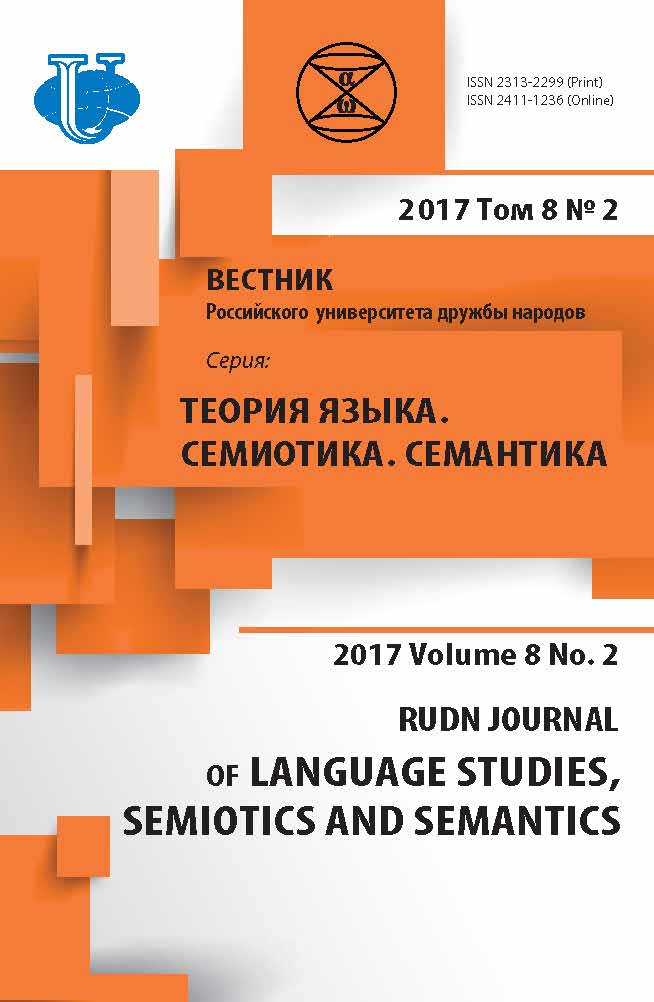Types of Semiotic Similitude in Dramatic Discourse: Transformation of a Play into a Theatrical Performance
- Authors: Loginova EG1
-
Affiliations:
- Ryazan State University named for S.A. Esenin
- Issue: Vol 8, No 2 (2017)
- Pages: 420-429
- Section: ARTICLES
- URL: https://journals.rudn.ru/semiotics-semantics/article/view/16352
- DOI: https://doi.org/10.22363/2313-2299-2017-8-2-420-429
- ID: 16352
Cite item
Full Text
Abstract
The article is aimed at presenting types of semiotic similitude of the communicatively related semiotic acts in heterogeneous discursive space, namely dramatic discourse which includes monomodal discourse (play) and polymodal discourse (theatrical performance). Making an attempt to reveal the functional basis for intrasemiotic and intersemiotic code metamorphoses within the semiosphere of dramatic discourse the author pays special attention to analogy as a cognitive universal which ensures orderliness across modalities and thus accounts for integrational and complementary nature of communication. Model construction is chosen as a method of analyzing the characteristics and directions of semiosis in dramatic discourse. It makes it possible to define two types of semiotic similitude in dramatic discourse (semiotic identity and image) and to single out four interdependent vectors seen as a model which brings about orderliness through analogy when we deal with heterogeneous discursive space.
About the authors
E G Loginova
Ryazan State University named for S.A. Esenin
Author for correspondence.
Email: e.loginova@rsu.edu.ru
46 Svoboda St., 390000, Ryazan, Russia
References
- Bobkova, P.V. (2011). Ontological characteristics of electronic mass media hypertext and perspectives of its research in linguistics. Bulletin of MSLU, 14 (620), 7—15. (in Russ).
- Dal, V.I. Explanatory dictionary of the living great Russian language. URL: http://www.dict.t-mm.ru/dal (accessed: 30.09.2016). (in Russ).
- Zalevskaya, A. (2016). A. Psycholinguistic problems of semiosis. Journal of Psycholinguistics, 3(29). (in Russ).
- Lotman, Yu.M. (1996). Inside minded worlds. Human — text — semiosphere — history. Moscow: Jazyki russkoj kul'tury. (in Russ).
- Lotman, Yu.M. (1998). About the Art. SPb.: Art-SPB. (in Russ).
- Plotnikova, S.N. (2011). Discourse as a space: a new approach. Digital scientific and pedagogical journal of Eastern Siberia «Magister Dixit», 2 (06). URL: http://md.islu.ru (accessed: 4.10.2016). (in Russ).
- Stuart, J. (1990). Back to symbolic modeling: nonrepresentative model of language essence. In: Polyakov, I.V. (Ed). Sign systems in social and cognitive processes. Novosibirsk. (in Russ).
- Ustinova, E.S. (2010). Towards a «holographic» vision of vocabulary viewed in multiple dimensions. Foreign languages in higher education, 2(13). (in Russ).
- Ushakov, D.N. Explanatory Dictionary of the Russian Language. URL: http://www.dict.t-mm.ru/ ushakov (accessed: (30.09.2016). (in Russ).
- Eco, U. (1998). La Struttura Aassente Assente Introuaione. Ala Ricerca Semiologica. Moscow. (in Russ).
- Harris, R. (1996). Signs, Language and Communication. London and New York: Routledge.
- Harris, R. (2009). Integrationist Notes and Papers. 2006—2008. Gamlingay: Bright Pen.
Supplementary files












